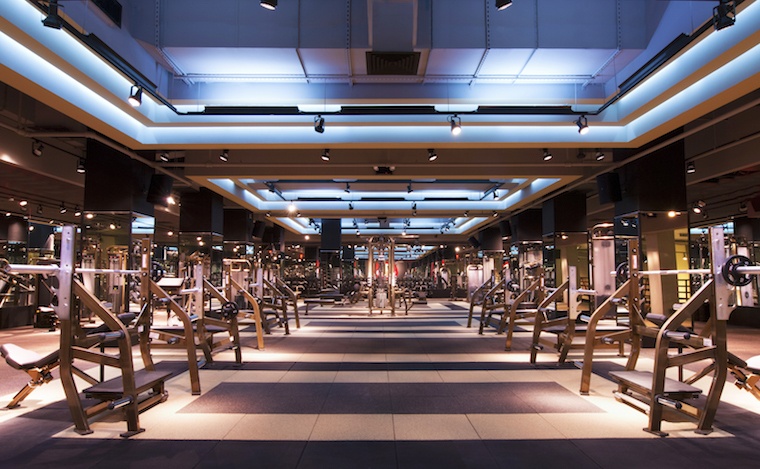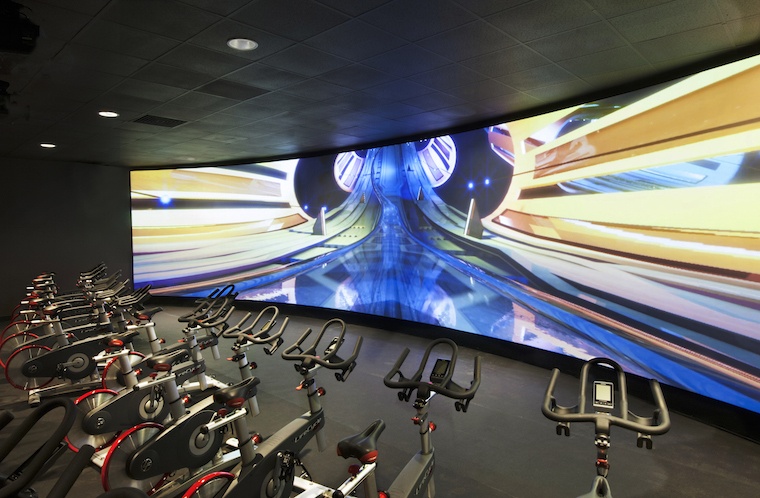The Man Who Made Going to the Gym Cool Is Back in Action
We're descending the stairs for a tour of TMPL, a sprawling, underground 40,000-square-foot manifestation of his vision of body-perfection-for-all, his dinner plate-sized pecs—bulging out of an off-the-shoulder deep V-neck t-shirt—leading the way.
TMPL opened in New York City's Hell's Kitchen in March, with serious space for cardio and strength training, a group fitness studio that fits 75, a Les Mills virtual reality spin program, a saltwater pool lit in computer-controlled colored lights, and a juice bar, to cite just a few of its features.

And it marked Barton's return to a New York City fitness scene he's been away from for a few years (after he sold his eponymous gym chain in 2013) but had a mega influence on creating. Decades before celebrities snapped selfies of themselves at SoulCycle and studios like 305 Fitness built light shows into their workout spaces, Barton bucked the current standards (like fluorescent lighting and white-washed walls) and brought nightclub decor, dim lighting, disco balls, and DJs to fitness. "I just wanted to create an environment that was a little more cool," he says, reflecting on opening that first space in 1992, which he remembers as "like...a hundred years ago."
We caught up with Barton, the godfather of boutique fitness, as he showed us around TMPL, his newest work of fitness art.
What made you want to do it all over again?
I love what I do, I love this. I had a vision for a gym that was a little bit different. There were some things I wanted to do that would really update the traditional health club model a little bit. And once I have an idea I just have to see it come to life. That’s what I get out of this. I like to make a buck, sure, but to realize my vision and see people come and work out and appreciate this is amazing.
How is that vision being realized here? What's unique about TMPL compared to your past projects?
One of the new things we’re doing is metabolic assessment. We're going to have equipment for measuring body composition, and we have this machine that does a 3D scan of your body. It’s to get a really predictable and accurate outcome at the gym. Without uncovering what’s going on with the metabolism, it’s really not a predictable process to change the body through diet and exercise, because people are metabolically different. One-size-fits-all diet and exercise programs have not worked. If they did, there would be one diet book on the shelf and everyone would read it and everyone would be thin.

So will you create individualized protocols for members that trainers can then reference?
If somebody’s working with a trainer, the trainer will be able to create protocols based on that information, but also if somebody is working out on their own, they can access a web-based program with information on how to train. The computer will tell you what I would have you do. It might be better if I told you to do it and stood by your side, but this is like a next best thing.
To me, it’s the holy grail to be able to tell somebody, "This is exactly what you need to do to look exactly like that."
It sounds like you're really excited about this aspect of the business.
To me, it’s the holy grail to be able to tell somebody, "This is exactly what you need to do to look exactly like that." It's not just the precision of science, but also with the efficiency of the computer, we can do it for everyone. Now, we don’t have to treat the whole membership as one homogeneous thing. We didn't have the technology before, and even the metabolic science and systems biology that went into this assessment is relatively new and groundbreaking.

{{post.sponsorText}}
What about the gym cool factor? When you look at how the boutique fitness scene is now so in line with what you did in the '90s, how does it feel?
I usually don’t really think about it. I came from this sort of underground downtown scene with people who wouldn’t be caught dead in a gym because it wasn't cool enough, so I wanted to make it okay for those people to go to the gym—and I did. The other thing I wanted to do was try to give people more of a chance of having a better, tangible outcome from going to the gym. Because most of it was "here’s a gym, there’s the equipment, there’s the locker room," and you see people year after year looking the same. I really tried to impact the...sort of...the product that we offer—which is really changing the body.
Want to know about some interesting workout science? This new fitness class is designed to train your brain.
Loading More Posts...